Конспект уроку з англійської мови для 8-го класу на тему "Travelling Around British Cities"
Конспект уроку з англійської мови для 8-го класу на тему "Travelling Around British Cities" з елементами рольової гри, що сприяє ефективному засвоєню матеріалу.
Lesson 5
Theme. Travelling Around British Cities
Objectives:
- Practical: to operates facts about the cities of Great Britain;
- Educational: to develop pupils’ skills of listening and reading; to activate their speaking skills and encourage them to use vocabulary on the topic; to teach students to gain, analyse and use information.
- Developing: to develop pupils’ memory, their ability to make up dialogues on given problems, to work in pairs; to stimulate pupils’ thinking and develop their creative imagination.
- Upbringing: to develop pupils’ interests to travelling and desire to know as much as possible about Great Britain.
Equipment: cards, the map of the UK, pictures, “Mind Map”, the texts for reading and listening, video film, computer presentation of London, leaflets.
Type of the lesson: lesson travelling.
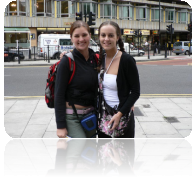
Procedure
Cities and Thrones and Powers
Stand on times eye
Almost as long as flowers,
Which daily day:
But, as new buds put forth
To glad new men,
Out of the spent and unconsidered Earth
The cities rise again.
Rudyard Kipling
I. The beginning of the lesson.
1. Greeting.
T: Good morning, children! I am pleased to see you at our lesson. Do you have a good
mood today? Are you happy? What will you have soon? How are you going to spend
your spring holidays? I’m glad you are all right and we’ll have wonderful minutes of
communication. Let’s begin our English lesson.
2. Introduction the theme and aims.
T: The theme of our lesson is “Travelling around Great Britain”. Today we are going to travel around Great Britain and learn more about the largest cities of this country. You’ll learn about the life of the people there, their traditions and their cultural peculiarities. We’ll practice in speaking, listening, reading and grammar. By the end of the lesson you should be able to give your own points of view on the topic, talk about the British cities and develop listening, reading, speaking and writing skills.
3. Warming up.
T: What words do you associate with topic of our lesson? Do you remember the names of main cities features? Let’s make up “Mind Map” according to our topic.
![]() Large squares Modern galleries Theatres
Large squares Modern galleries Theatres
![]()
 Beautiful streets Green shady parks
Beautiful streets Green shady parks
![]()

![]()
Old churches Universities
|
|
Interesting museums
Long avenues Large squares Ancient cathedrals
T: Make up as many sentences as you can to describe a modern town or city.
II. The main part of the lesson.
1. Revising vocabulary.
T: We have already learned a lot of information about Great Britain. Let’s revise our knowledge. I hope that you learn English words every day. To check your knowledge I’ve prepared the following task for you. You should give the corresponding words for the following definitions. Let’s write the word-dictation.
1. ____ the weather a certain place has over a long period of time. (Climate)
2. ____ a person who lives in a town or country. (Inhabitant)
3. ____ a line separating two countries. (Border)
4. ____ people living in a country. (Population)
5. ____ a large area of land that is without water and trees, often sand covered. (Desert)
6. ____ a mountains region. (Highlands)
7. ____ a field covered with grass. (Meadow)
2. “Brain Ring”.
T: To my mind we can’t go anywhere if we know nothing about the place. Thus, our task today is to find out if Great Britain is worse visiting. You know millions of people from different countries visit some British cities every year because they are really beautiful. We are travelling to London. But you’ll be invited to the UK on condition you know British geography, history, culture and traditions well. Do all your best to refresh your knowledge about the United Kingdom in order to win an invitation to London.
Now we’ll play “The brain ring”. You are divided into two teams as usual. Please, answer the questions and count the points.
1. What is the official name of the country?
(The United Kingdom of Great Britain and Northern Ireland)
2. What is the capital of the UK? (London)
3. What is the highest mountain of Great Britain? (Ben Nevis)
4. What river does London stand on? (The Thames)
5. What is the population of London? (8 million)
6. What kind of climate is there in Great Britain? (Mild and damp)
7. What industries are developed there? (Steel industry, textile industry, paper-making)
8. What big cities of the UK do you know? (London, Birmingham, Glasgow, Manchester, Liverpool, etc.)
9. What are university cities? (Oxford, Cambridge)
10. What is “Smog”? (Smoke+fog)
11. What is the Union Jack? (The flag of the UK)
12. What does the word Oxbridge mean? (Oxford+Cambridge)
13. What flower is the symbol of England? (Rose)
14. What do the English usually have at 5 o’clock? (Tea)
15. Why is it difficult to know if an Englishman is married? (They do not wear wedding rings)
16. What is Cenotaph? (A monument)
17. What is the capital of Scotland? (Edinburgh)
18. What is Edinburgh famous for? (For printing houses)
T: That’s all. What is the score? I think that we all get a prize – an invitation to the UK. But winners will take the first class seats, and you will fly the second class.
3. Listening “Britain and the British”.
T: Be so kind to imagine that you are on the board of a modern airplane. Fasten seat belts, please! Travelling around some British cities, let’s find out some information about Britain and the British.
1) Pre-listening activities.
T: a) Before listening learn to read and pronounce the names of some British cities. Find them on the map.
Manchester
Liverpool
Bristol
Portsmouth
Birmingham
Stratford-upon-Avon
Leeds
2) While-Listening Activity.
T: a) Listen to the text and fill in the table with the names of people who inhabit the United Kingdom.
|
Country |
Capital |
People |
Language |
|
Great Britain |
London |
The British |
English |
|
England |
London |
|
English |
|
Scotland |
Edinburgh |
|
English, Gaelic |
|
Wales |
Cardiff |
|
English, Welsh |
|
Northern Ireland |
Belfast |
|
English, Irish |
Britain and the British
The United Kingdom is a multinational country today, but its peoples make up a unity. They call themselves British. Everyone who was born in Britain is British.
But don’t call a Welsh or Scottish person English! He won’t like it! Only people from England can be called English. People from Scotland, Wales or Northern Ireland are not English. They are Scottish or the Scots, Welsh and Irish.
More than 56 million people live in Britain. Many of them live in big industrial cities like London. Manchester and Liverpool, for example, are the biggest industrial cities in the centre of England. Other industrial cities are Leeds, Birmingham, Sheffield and others.
Such cities as Plymouth, Portsmouth and Liverpool are big ports, where many sailors and fishermen live. Bristol is not a very large port. It is smaller than others, but it’s very beautiful because it’s a royal port.
Stratford-upon-Avon is a very interesting town and the birthplace of famous Shakespeare. There is a church where he is buried.
Everyone in Britain speaks English. But in some parts of Scotland and Wales people speak different languages as well. The Welsh are especially proud of their language. They like to speak Welsh, to sing songs in Welsh, and when you travel you can see road signs in Welsh all over Wales.
Everyone in the UK speaks English but they all speak it differently. A Scottish person has to listen carefully if he wants to understand a Londoner or a Welsh person.
T: b) Say if it is true or false.
1. Everyone who was born in England is British.
2. We cannot call Welsh or Scottish people English.
3. The population of Britain is more than 56 million people.
4. People mostly live in big industrial cities.
5. The biggest industrial centers of Scotland are Liverpool and Manchester.
6. Many sailors and fishermen live in Plymouth, Portsmouth, and Liverpool.
7. William Shakespeare was born and buried in Stratford-upon-Avon.
8. English is the only language spoken in Britain.
9. The Welsh are proud of their language and like to speak it.
10. The people in the UK speak English differently.
3) Post-Listening Activities.
T: Listen about the population of Great Britain again and do some tasks.
a) Complete the sentences choosing right answers.
1. More than _______ million people live in Britain.
a) 65 b) 46 c) 56
2. ... are the biggest industrial cities in the centre of England
a) Manchester and Leeds
b) Liverpool and Manchester
c) Leeds and Birmingham
3. Many sailors and fishermen live in Liverpool, ....
a) Plymouth and Portsmouth
b) Sheffield and Portsmouth
c) Portsmouth and London
4. ... is the birthplace of famous Shakespeare.
- Bristol
- Manchester
- Stratford-upon-Avon
5. In some parts of... and Wales people speak other languages besides English.
a) England b) Scotland c) Britain
6. Everyone in the UK speaks English ....
a) clearly
b) in the same way
c) differently
b) Use the table you have copied and name the capitals of:
-England -Northern Ireland -Scotland -Great Britain -Wales
What country has the same capital as Great Britain on the whole?
c) Arrange the items of the plan of the text in the correct order and retell the text.
Plan.
- Industrial cities.
- The English language.
- The UK is a multinational state.
- Big and famous ports.
- Shakespeare’s birthday.
4. Reading.
1) Pre-Reading Activity.
T: Not to be bored during the flight I advise you to learn some facts from the history of London. Have a look at some new words.
Caesar – Цезар
to conquer – завойовувати
plague – чума
clear away – звільнитися
T: Read the quotations. Do you agree with them or not? Let’s discuss them.
- “There are two places in the world where men can most effectively disappear – the city of London and the South Sea”. (Herman Melville)
- When a man is tired of London, he is tired of life, for there is in London all that life can afford”. (Samuel Johnson)
- “I hope to see London before I die”. (W. Shakespeare “Henry IV”)
2) While-Reading Activity.
T: While reading mark if the statements are true or false.
1. London is a young and very large city.
2. London is two thousand years old.
3. Napoleon founded this settlement.
4. The Romans named it “Llyndin” that means “island”.
5. In Roman times London was a large and rich city.
6. Saxons ruined the city.
7. London was rebuilt in the 10th century.
8. The Great Fire helped to clear away the dirty city.
London
London, the capital of Great Britain is one of the oldest and largest cities in the world. They say London is two thousand years old.
To the small settlement in the year 55 B.C. Caesar came from Rome. “Llyndin” that means “a lonely place” became Londinium. The Romans made Londinium the large and rich city with good streets, beautiful palaces, shops and villas. But in the fifth century Romans left Britain.
Saxons and Danes conquered the land and ruined the city. Londinium lay in ruins for a long time. In the 9th century Saxon king rebuilt the city.
For a long period of time London was a rich and crowed city, but in 1665 the Plague fell upon London. It came from one of the ship which came to the city every day. The houses of sick had a red cross painted on the door. In 1666 the Great Fire destroyed 3000 houses and 97 churches in London. But the Fire cleared away the old dirty wooden houses. A new London – of stone – was built.
3) Post-Reading Activity.
T: Answer the questions.
1. How old is London?
2. Who came to this place in 55 B.C.?
3. What kind of town did the Romans make?
4. Saxons and Danes conquered the land, didn’t they?
5. Who destroyed the city?
6. Did Saxon king rebuild London?
7. Why did some houses have red crosses painted on the door?
8. When did Great Fire destroy 3000 houses and 97 churches in London?
T: Retell the text.
5. Relaxation.
T: Comment on the joke.
During the rush hours a group of women got on a London bus but every seat was already occupied. The conductor noticed a man who seemed to be asleep.
“He’ll miss his stop”, he thought and coming up to the man he said, “Wake up”. The man opened his eyes and looked at the conductor in surprise.
“I wasn’t asleep”, he said.
“Not asleep? But you had your eyes closed”.
“I know. I just hate to see ladies standing up in a crowded bus”, answered the man.
6. Watching video.
T: What city of Great Britain you want to visit and why.
P: I’d like to visit … because … .
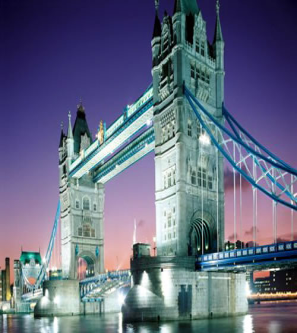

T: You can see some fragments about London.
7. Speaking. Checking home task (Role-play).
T: Now we are in London. We’ll make an excursion about this beautiful city. Who wants to be a guide? Come to the screen and tell us about London’s sights.
London is the capital of Great Britain. More than 8 million people live in London. London lies on both banks of the river Thames. It is the largest city in Europe and one of the largest cities in the world.
London is not only the capital of the country, it is also a very big port, one of the greatest commercial centres in the world, a university city, and the seat of the government of Great Britain.
P1: London consists of four parts: the City, Westminster, the West End and the East End. The heart of London is the City, its financial and business centre. Numerous banks, offices and firms are situated there, including the Bank of England, the Stock Exchange and the Old Bialy. Few people live there, but over a million people come to the City to work. There are some famous ancient buildings, such as St. Paul’s Cathedral and the Tower of London.
St. Paul’s Cathedral is the most famous church in London. St. Paul’s serves as the centre of the Church of England in London. The great English Architect Sir Christopher Wren built it between 1675 and 1710 to replace the original St. Paul’s, which was destroyed in the Great Fire of 1666. The church’s huge dome towers 111 meters above the ground. Its dome has become a symbol of London throughout the world.
P2: The Tower of London is a very old building. It is nine hundred years old. The Tower of London stands on the Thames. In the early days of the history of England the English kings lived in the Tower. Then it was a prison where many people lost their heads. Black ravens had much food near the walls of the Tower in those years.
The black ravens live in the gardens of the Tower now. There is a legend that the Tower will fall if it loses its ravens. Perhaps, that’s why the English people like them very much. A man looks after the ravens and gives them meal in the morning and in the evening.
The Tower of London is a museum now and many tourists from other countries come to see it. They see the dark stone walls with small windows and thick doors. The walls of the Tower are five meters thick.
At ten o’clock every evening the guard lock the big doors of the Tower for the night.
P3: Westminster is the administrative part of London. Nearly all English Kings and Queens were crowned and buried in Westminster Abbey. Many great English scientists lie buried there, among them Newton, Darwin. In the Poet’s Corner some of the famous English poets and writers are buried.
Now you can see the Houses of Parliament and Big Ben. The Houses of Parliament is the seat of British government. It is a very large Gothic building. Its length is 280 meters. Big Ben is the name of the huge clock on the Clock Tower of the Houses of Parliament.
P4: The West End is the richest and the most beautiful part of London. It is the symbol of wealth and luxury. You can find the best shops, restaurants, theatres, cinemas, museums, fine parks and squares there.
Trafalgar Square is the main square of central London. A number of famous buildings and monuments, including the National and Nelson’s Column are situated there. The square is popular with visitors, who come to relax by the fountains or to feed the pigeons. Piccadilly Circus is the meeting of six streets.
Buckingham Palace is the Queen’s official London residence. Buckingham Palace is like a small town, with a police station, two post offices, a hospital, a bar, two sports clubs, a disco, a cinema, a swimming pool. There are 600 rooms and three miles of red carpet. About 700 people work in the Palace. It is partially open to the public, but the ceremony of Changing of Guard in front of it, is a great tourists attraction.
There are many parks in London. The most famous are Hyde Park, St. James’s Park and Green Park.
P5: The East End is the poorest district of London. The East End is the “hands” of the capital. Working people live there. These hands have built the City banks, the palaces, theatres and shops of the West End. They have built up the wealth of Great Britain. There are few parks in this part of London.
T: Imagine that we are having a press conference devoted to London. Some of you will be famous reporters of such British newspapers as “The Times”, “The Star Business”, “The Independent”, “Weekend” and of the magazine “Woman’s Weekly”. And the others are tourists that visited London. Please, ask our tourists some questions about London.
P1: Good afternoon. I’m a correspondent from the newspaper “The Star Business”. What sights of London did you visit?
T1: We visited the Tower of London, Westminster Abbey, the Houses of Parliament and many others.
P2: I’m a reporter from the newspaper “The Times”. What did you find out about the Tower of London?
T2: It is one of the oldest and best-known places of interest of London. In the course of history it has been a fortress, a royal palace, a state prison, a citadel and an arsenal. Now it is a museum.
P3: I’m a correspondent from the English magazine “Woman’s Weekly”. Did you like the House of Parliament?
T3: Of course we did. The Houses of Parliament are situated in Westminster. It is the seat of the British Government. Its Clock Tower is known all over the world as a symbol of London and Britain. It has a large clock and a bell known as Big Ben.
P4: I’m a correspondent from newspaper “The Independent”. What interesting facts about Westminster Abbey can you tell?
T4: Westminster Abbey is another famous place of London. It is the place where all British kings and queens were crowned and buried. There you can also find the Poets’ Corner which is the resting place of some famous writers and poets like Ch. Dickens, and r. Kipling.
P5: I’m a correspondent from the English newspaper “Weekend”. Did you see the Buckingham Palace?
T5: Yes, we did. It is London residence of the British Monarch. It takes its name from the house built early in the 18th century. In 1761 George III bought this house for his wife and since then it is known as “queen’s house”.
8. Pair work.
T: Make up some dialogues like these ones and act them out.
1) - Excuse me, can you tell me the way to Trafalgar Square?
- Certainly. Go down Regent Street to Piccadilly Circus and in a few minutes you’ll be in Trafalgar Square.
- Thank you very much! How far is it from here?
- If you walk, it’ll take you ten minutes.
- Is there a bus?
- There’s sure to be. But you’d better ask the policeman over there. He will give you all the information you want.
- Thank you.
2) - Excuse me, Officer, is there a bus from here to Trafalgar Square?
- Yes, sir, any bus will take you. There’s a bus stop just over there. Ask the conductor to put you down at Trafalgar Square.
- Thank you.
3) Guide: Ladies and gentlemen! We are in the heart of our capital — the City of London. This is Tower Bridge, the most striking of all London’s bridges. It was built in 1894, but even today Tower Bridge regulates a large part of the
impressive traffic of the port of London. You see it is full of life and activity but the continual stream of traffic is stopped
every now and then by a bell.
Si mon: Look! The bridge is parting in the middle, and the two halves are moving upwards.
Victor: A big steamboat is passing underneath.
Guide: It won’t take longer than a minute and a half to restart the traffic. Ladies and gentlemen, down river stretch the London docks where ships are loaded
and unloaded.
9. Group work.
T: Make group of 2. In groups discuss the most attractive places of historical interest of London. Then plan a programme for a London sightseeing tour for a weekend. Try to persuade the others that your programme is the most interesting and should be accepted.
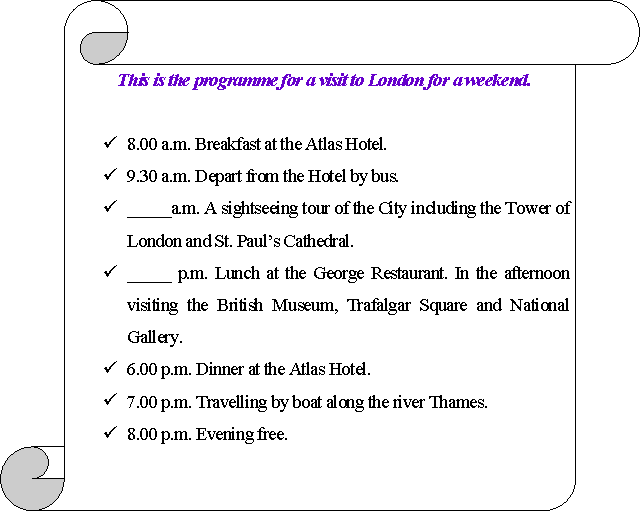 Group 1:
Group 1:
Group 2:
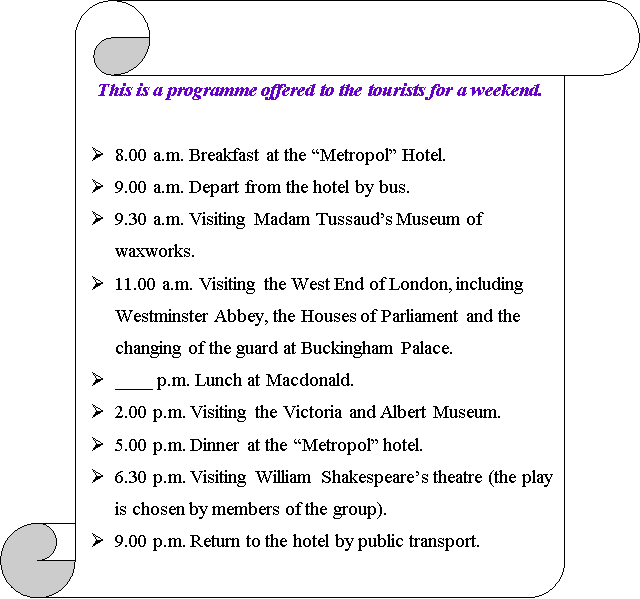
10. Writing.
T: After a long walk we are tired. Let’s stop at the hotel and share our impressions with our friends. Write about them in the letter where some words are missing.
Dear friends!
I’m writing from London, the c______ of Great Britain.
We’re staying in a large hotel on Trafalgar Square. This is the m______ square of the c______.
London looks like a h______ park with its b______ flowers and g______ trees. Yesterday we met some really friendly people who took us to round London t______.
We visited the St ______ Cathedral. The b______ of this cathedral is really m______. We saw the official r______ of the British m______. It is located in a very beautiful p______.
We were impressed by great number of p______ and s______. They m______ London is very attractive to the tourists.
So we are having a lovely time.
See you when I get back. Miss you.
Love.
11. Crossword “Find sights of London”.
|
E |
W |
K |
J |
Y |
F |
H |
Y |
G |
L |
|
T |
E |
S |
Q |
X |
D |
A |
Z |
E |
O |
|
L |
V |
T |
M |
I |
N |
N |
J |
P |
N |
|
T |
Q |
U |
J |
E |
D |
S |
R |
A |
D |
|
H |
J |
W |
J |
R |
X |
T |
E |
R |
O |
|
N |
K |
A |
U |
F |
T |
O |
W |
K |
N |
|
B |
E |
A |
M |
H |
J |
C |
G |
D |
Z |
|
V |
G |
S |
T |
E |
V |
X |
I |
H |
O |
|
I |
G |
B |
E |
N |
S |
Z |
S |
T |
O |
|
B |
O |
L |
O |
D |
O |
A |
S |
O |
Y |
Keys: (London Zoo, Westminster, Hyde Park, Tower, Thames, East End, Big Ben, City).
12. Singing the song “My Bonnie”.
T: Our excursion came to an end. It’s high time to fly back to Ukraine. Feel yourselves comfortable in your seats, relax and sing a folk English song.
T: You are tired of a lot of information and work. Let’s relax and sing a folk English song.
My Bonnie lies over the ocean,
My Bonnie lies over the sea,
My Bonnie lies over the ocean,
Oh bring back my Bonnie to me!
Chorus:
Bring back, bring back, bring back
my Bonnie to me, to me;
Bring back, bring back, oh bring
back my Bonnie to me!
Oh blow ye winds over the ocean,
Oh blow ye winds over the sea,
Oh blow ye winds over the ocean,
And bring back my Bonnie to me.
Chorus: Bring back, etc.
Last night as I lay on my pillow,
Last night as I lay on my bed,
Last night as I lay on my pillow,
I dreamed that my Bonnie was dead.
Chorus: Bring back, etc.
The winds have blown over the ocean,
The winds have blown over the sea,
The winds have blown over the ocean,
And brought back my Bonnie to me.
Chorus: Bring back, etc.
III. Finishing of the lesson.
1. Summing – up.
T: Let’s sum up the results of our trip. We had an interesting communication at the lesson. I hope you liked it.
2. Homework.
T: Write a letter to your friend about your trip to London. Don’t forget about the strict order of writing an address.
3. Analysis of pupils’ answers. Assessments.
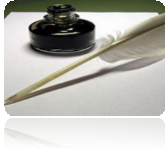
1


про публікацію авторської розробки
Додати розробку


